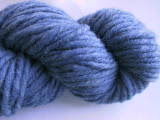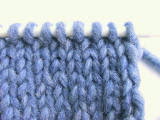

Yarn Profile: Fisherman's Bulky First Impressions
Today, Bartlett Yarns still spins its yarns on a mule spinning frame, one of the last of its kind still operating in the United States. This device duplicates a handspinner's motion, producing a loftier yarn with a soft twist. Fisherman's Bulky is a true unspun bulky that's similar to Icelandic wool but much softer and loftier. It is also somewhat similar to Cleckheaton Gusto. The color card for this yarn includes four yarns that are free of all dyes and chemicals. Knitting Up
As with any bulky yarn, Fisherman's Bulky gives your hands a true workout. There was only oddity: As I knit, I noticed that the yarn kept twisting tighter and tighter. I'd calm the spin by running my fingers down a length of the yarn, distributing the twist more evenly. When the spin was too much, I had to stop and dangle my work in mid-air, letting it spin itself out until things were back to normal. Blocking / Washing
My swatches required almost no blocking beyond a gentle press with a towel. Because of their bulk, however, they took a long, long time to dry. Soon they felt dry to the touch, but when pressed in a towel, they'd exude more moisture. This means the yarn is perfect for wet weather (hence the name, Fisherman's Bulky). Wearing
The drawback, however, is that you may feel like the Pillsbury Dough Boy if you aren't careful. If this worries you, stick to patterns that include a moderate amount of shaping. Even a few tucks here and there make a huge difference. The combined loose spin and jumbled, woolen texture make Fisherman's Bulky somewhat more susceptible to wear, especially at high-stress points. When piecing together your finished Fisherman's Bulky garments, I strongly urge you to use a similar-colored yarn but with a tighter, finer spin for added strength and ease of manipulation. Conclusion
While it's true that Fisherman's Bulky is significantly softer and loftier than Bulky Lopi, it may be too bulky for any significant color work. One layer is thick enough. Add a second layer of stranded colors along the back side and you may have a sweater that's simply too thick for comfortable, fashionable wear, unless you live in the Arctic. Lopi aside, Fisherman's Bulky is a good solution when you want a quick-knitting, 100% wool yarn. |
Yarn name
Fisherman's Bulky
Manufacturer
Bartlett Yarns
Fiber content
100% wool
Gauge
None given on label, but Bartlett's Web site mentions 3 stitches per inch on US 10.5 needles
Average retail
price
$5.25/ skein
Where to Buy Online
Bartlett Yarns
Weight/Yardage per Skein
4 oz. / 80 yards
Country of Origin
U.S.A.
Manufacturer's
suggested wash method
Care for it as you would any fine woolen garment.
Review date
12/12/2001 |
Copyright © 2000-2016 Clara H. Parkes
All rights reserved. Permission to reproduce is required.
All rights reserved. Permission to reproduce is required.
